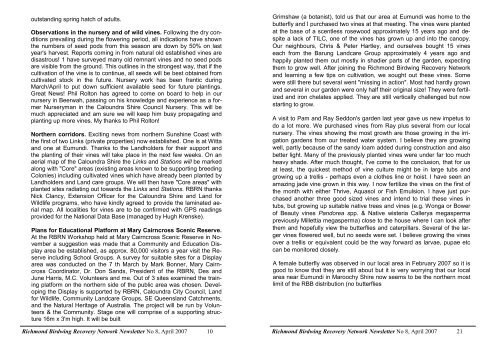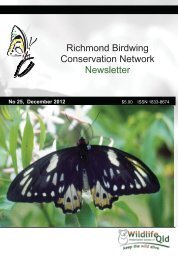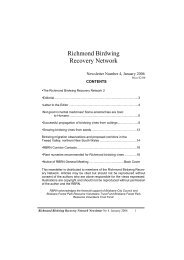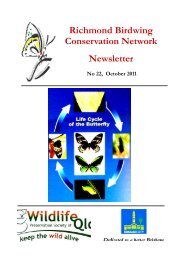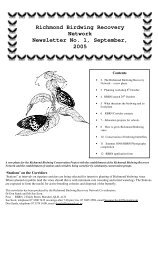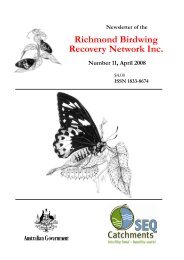Newsletter - Richmond Birdwing Conservation Network
Newsletter - Richmond Birdwing Conservation Network
Newsletter - Richmond Birdwing Conservation Network
You also want an ePaper? Increase the reach of your titles
YUMPU automatically turns print PDFs into web optimized ePapers that Google loves.
outstanding spring hatch of adults.Observations in the nursery and of wild vines. Following the dry conditionsprevailing during the flowering period, all indications have shownthe numbers of seed pods from this season are down by 50% on lastyear's harvest. Reports coming in from natural old established vines aredisastrous! 1 have surveyed many old remnant vines and no seed podsare visible from the ground. This outlines in the strongest way, that if thecultivation of the vine is to continue, all seeds will be best obtained fromcultivated stock in the future. Nursery work has been frantic duringMarch/April to put down sufficient available seed for future plantings.Great News! Phil Rolton has agreed to come on board to help in ournursery in Beerwah, passing on his knowledge and experience as a formerNurseryman in the Caloundra Shire Council Nursery. This will bemuch appreciated and am sure we will keep him busy propagating andplanting up more vines. My thanks to Phil Rolton!Northern corridors. Exciting news from northern Sunshine Coast withthe first of two Links (private properties) now established. One is at Wittaand one at Eumundi. Thanks to the Landholders for their support andthe planting of their vines will take place in the next few weeks. On anaerial map of the Caloundra Shire the Links and Stations will be markedalong with "Core" areas (existing areas known to be supporting breedingColonies) including cultivated vines which have already been planted byLandholders and Land care groups. We will then have "Core areas" withplanted sites radiating out towards the Links and Stations. RBRN thanksNick Clancy, Extension Officer for the Caloundra Shire and Land forWildlife programs, who have kindly agreed to provide the laminated aerialmap. All localities for vines are to be confirmed with GPS readingsprovided for the National Data Base (managed by Hugh Krenske).Pians for Educational Platform at Mary Cairncross Scenic Reserve.At the RBRN Workshop held at Mary Cairncross Scenic Reserve in Novembera suggestion was made that a Community and Education Displayarea be established, as approx. 80,000 visitors a year visit the Reserveincluding School Groups. A survey for suitable sites for a Displayarea was conducted on the 7 th March by Mark Bonner, Mary CairncrossCoordinator, Dr. Don Sands, President of the RBRN, Des andJune Harris, M.C. Volunteers and me. Out of 3 sites examined the trainingplatform on the northern side of the public area was chosen. Developingthe Display is supported by RBRN, Caloundra City Council, Landfor Wildlife, Community Landcare Groups, SE Queensland Catchments,and the Natural Heritage of Australia. The project will be run by Volunteers& the Community. Stage one will comprise of a supporting structure16m x 3'm high. It will be built<strong>Richmond</strong> <strong>Birdwing</strong> Recovery <strong>Network</strong> <strong>Newsletter</strong> No 8, April 2007 10Grimshaw (a botanist), told us that our area at Eumundi was home to thebutterfly and I purchased two vines at that meeting. The vines were plantedat the base of a scentless rosewood approximately 15 years ago and despitea lack of TILC, one of the vines has grown up and into the canopy.Our neighbours, Chris & Peter Hartley, and ourselves bought 15 vineseach from the Barung Landcare Group approximately 4 years ago andhappily planted them out mostly in shadier parts of the garden, expectingthem to grow well. After joining the <strong>Richmond</strong> <strong>Birdwing</strong> Recovery <strong>Network</strong>and learning a few tips on cultivation, we sought out these vines. Somewere still there but several went "missing in action". Most had hardly grownand several in our garden were only half their original size! They were fertilizedand iron chelates applied. They are still vertically challenged but nowstarting to grow.A visit to Pam and Ray Seddon's garden last year gave us new impetus todo a lot more. We purchased vines from Ray plus several from our localnursery. The vines showing the most growth are those growing in the irrigationgardens from our treated water system. I believe they are growingwell, partly because of the sandy loam added during construction and alsobetter light. Many of the previously planted vines were under far too muchheavy shade. After much thought, I've come to the conclusion, that for usat least, the quickest method of vine culture might be in large tubs andgrowing up a trellis - perhaps even a clothes line or hoist. I have seen anamazing jade vine grown in this way. I now fertilize the vines on the first ofthe month with either Thrive, Aquasol or Fish Emulsion. I have just purchasedanother three good sized vines and intend to trial these vines intubs, but growing up suitable native trees and vines (e.g. Wonga or Bowerof Beauty vines Pandorea spp. & Native wisteria Callerya megaspermapreviously Millettia megasperma) close to the house where I can look afterthem and hopefully view the butterflies and caterpillars. Several of the largervines flowered well, but no seeds were set. I believe growing the vinesover a trellis or equivalent could be the way forward as larvae, pupae etccan be monitored closely.A female butterfly was observed in our local area in February 2007 so it isgood to know that they are still about but it is very worrying that our localarea near Eumundi in Maroochy Shire now seems to be the northern mostlimit of the RBB distribution (no butterflies<strong>Richmond</strong> <strong>Birdwing</strong> Recovery <strong>Network</strong> <strong>Newsletter</strong> No 8, April 2007 21


